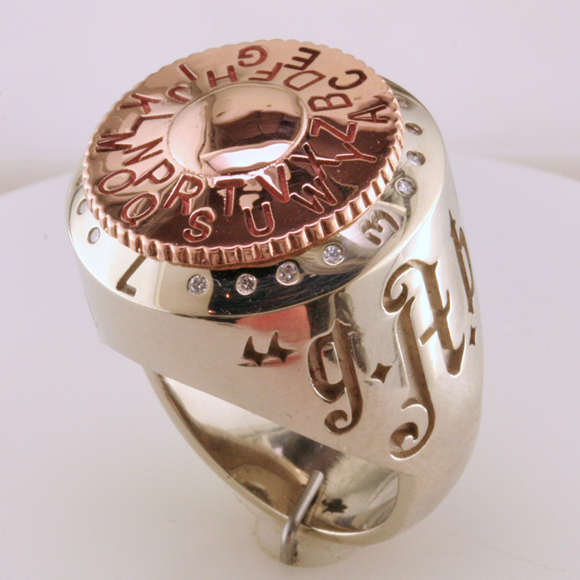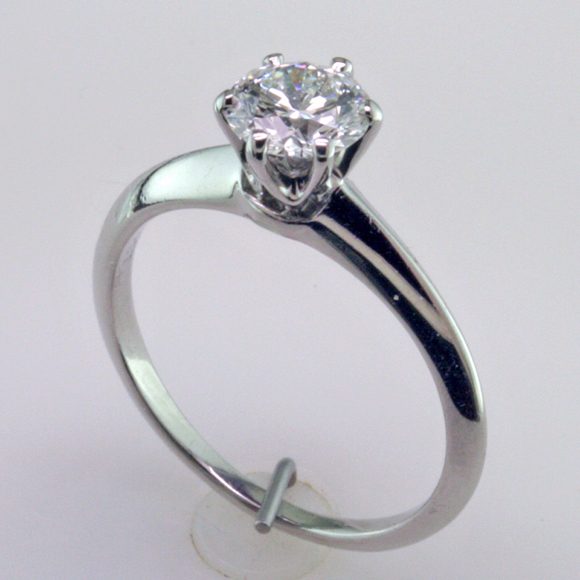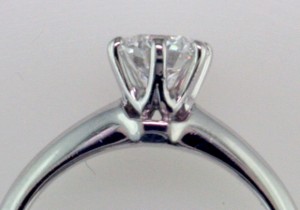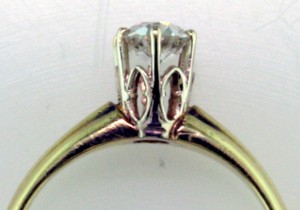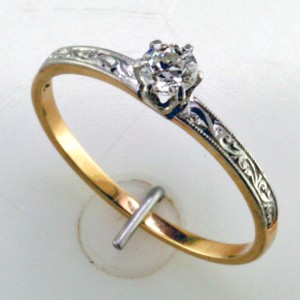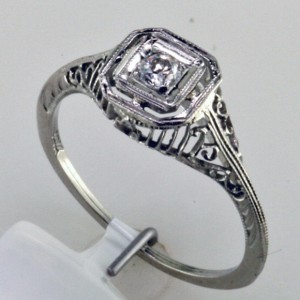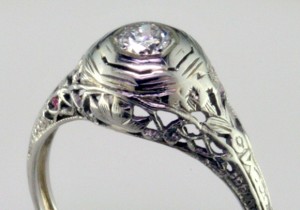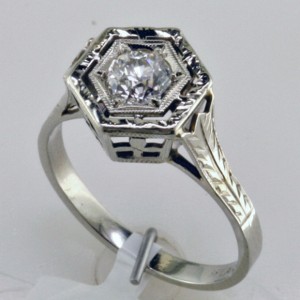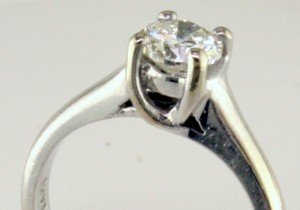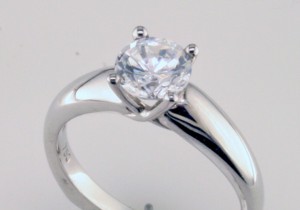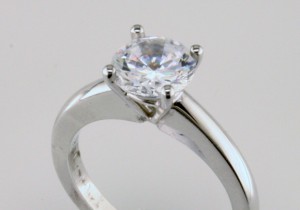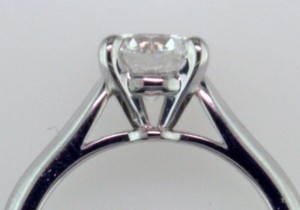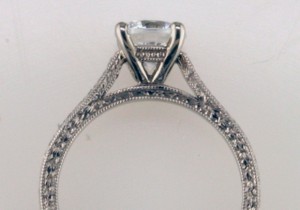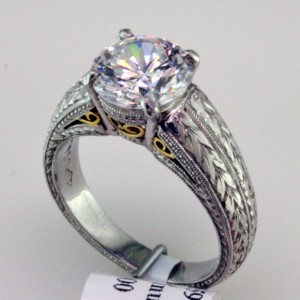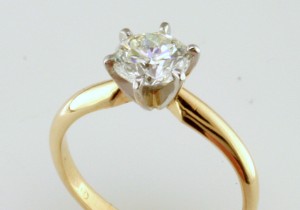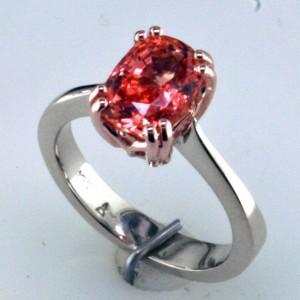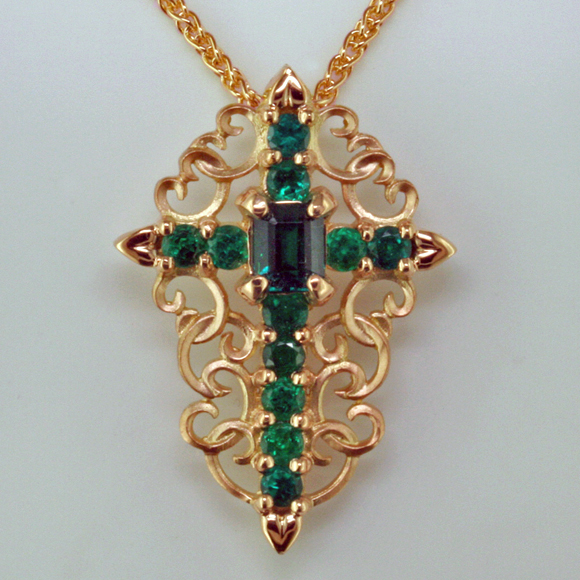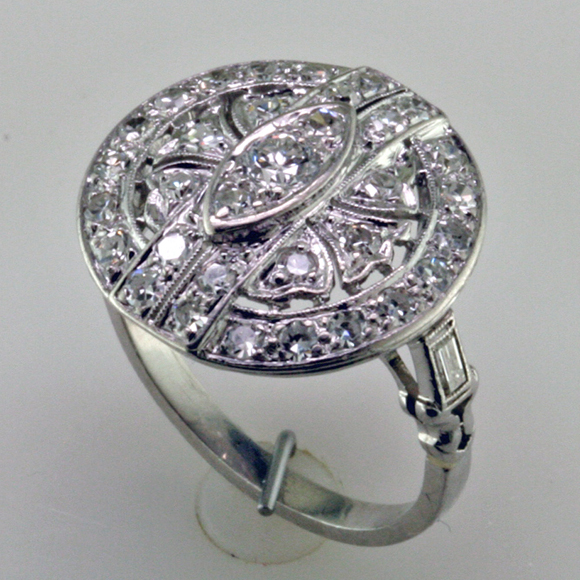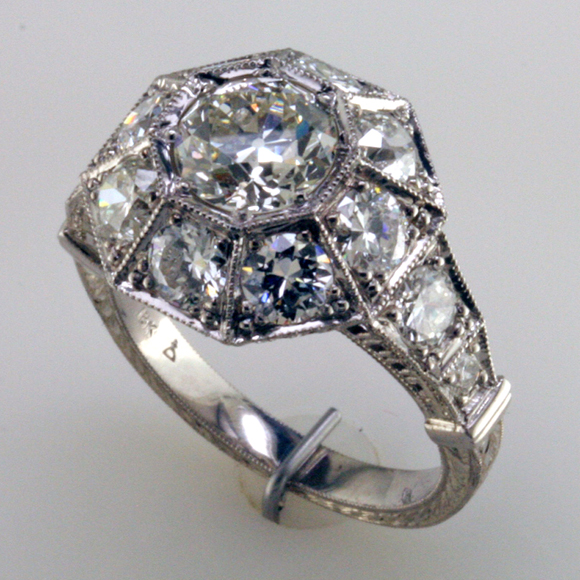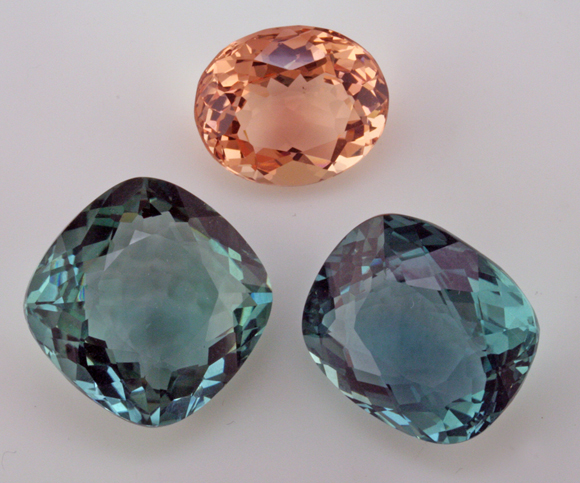
A client brought these three stones to our shop looking to sell them. She had purchased the stones while traveling and was under the impression the two 30 ct. greenish blue ones were aquamarines and the peachy pink stone was morganite.
At Mardon, as gemologists, we always buy gems very carefully and only when we know exactly what we are buying. The first things I noticed– that the greenish blue color was not quite right for aquamarine and the peachy pink was unusual for morganite– told me to proceed carefully. A preliminary observation with my trusty gemological microscope indicated the “aquas” were not aqua and the “morganite” was not morganite.
 My observations of the greenish blue stones showed more doubling than I would expect to see in aquamarine, and no doubling at all in the “morganite.” Doubling is a visual effect seen in gemstones that are doubly refractive– when you look thru these gems with magnification, you see doubled images of the inclusions and the facet edges on the opposite side. The effect is sort of like what you see when you look at 3D images without the special glasses.
My observations of the greenish blue stones showed more doubling than I would expect to see in aquamarine, and no doubling at all in the “morganite.” Doubling is a visual effect seen in gemstones that are doubly refractive– when you look thru these gems with magnification, you see doubled images of the inclusions and the facet edges on the opposite side. The effect is sort of like what you see when you look at 3D images without the special glasses.
Aquamarines and morganites, along with rubies, emeralds, sapphires and many other gems, are doubly refractive. When light enters these gems, it is polarized into two rays that travel at different speed/wavelengths depending on what axis or direction they travel. This is known as double refraction.
Not all gems are doubly refractive. Diamonds, garnets, spinels and glass are singly refractive, meaning that light is not polarized and travels at basically the same speed thru the gem no matter what direction.
The difference in the light speed of the two rays is an optical property known as birefringence. Birefringence creates the visual effect known in gemology as “doubling”– each of the polarized rays is seen separately, so we see doubled or blurred images of the various features within the stone. Aquamarine, a member of the beryl family, has a relatively small amount of birefringence compared with many other gems.
The test we gemologists most often use to prove the identity of a gemstone is to measure the birefringence and the RI (refractive index), a measurement of the ability of a transparent medium to bend (slow down) light. Gems, minerals, and transparent media have very specific and diagnostic RI’s. Using a device called a refractometer, my measurement of the bluish stones gave an RI reading of ~ 1.54 -1.55, with a birefringence of ~ 0.009, proving the material was quartz. Now the question was natural quartz or synthetic (man made) quartz.
In the microscope, I had noticed inclusions (internal growth characteristics) that looked like bread crumbs and tiny nails. Inclusions in both natural gems and synthetic stones are a result of the growth environment and show us how the materials were formed. I made a careful examination of these inclusions, comparing them with photos in John Koivula’s famous Photoatlas of Inclusions in Gemstones . The presence of these “nailhead spicules ” led me to conclude the stones were hydrothermally grown synthetic (manmade) quartz.
The peachy pink stone exhibited no doubling, i.e. no birefringence, meaning it was singly refractive. It had an RI of ~ 1.49, no observed inclusions and was hard to the touch of a pin, so my conclusion was that the stone could only be glass.
The field of gemology was born from the need to distinguish valuable gems from look-a-like imitations. Often, the imitation appears very much like the genuine article, so scientific methods of observation and testing are needed to separate the imitation from the genuine. Unfortunately, these imitations are often represented as the real thing and sold at high prices like the stones they mimic.
The incentives to cheat are great. Fine gems can be enormously valuable while imitations are usually produced very cheaply. For example, these 30 ct. synthetic quartz stones probably cost less than $100, while a good aquamarine of 30 carats could easily sell for $15,000! You can see how much profit can be made by cheating the buyer. Frequently, the sale is made by presenting the stone at prices “too good to be true.”
For reasons I cannot fathom, travelers seem to think their cash has greater purchasing power in foreign countries and are especially susceptible to these phony bargains. We are currently seeing lots of sad cases where our armed forces personnel are buying bogus gems in places like Afghanistan. They’re spending their truly hard earned dollars trying to make money buying misrepresented stones- synthetic rubies and sapphires sold as genuine, very low quality rubies, sapphires, and diamonds sold as high quality gems, etc. Really too bad — their “investments” will only remind them of their service in an unfriendly country, and not the money they made. The moral of the story is of course buyer beware— if you don’t know your gems or you don’t know the seller, resist the temptation to scoop up a bargain.
The gemstone trade is an ancient and honorable profession that has long been plagued by unscrupulous individuals misrepresenting cheap imitations as the real thing or low grade genuine stones as high quality. New technologies developed over the last few decades has substantially increased the number and types of imitations and treated gems coming to market so the problem is more acute than ever.
Fortunately, the gem trade and jewelry industry has met the challenge to stay ahead of the game by creating and supporting organizations like the Gemological Institute of America (GIA) which develop scientific methods to detect the new treatments and imitations. Additionally, the American Gem Society (AGS) and the American Gem Trade Association (AGTA), professional organizations of which we are members, have embraced the mission of consumer protection thru education of both jewelers and the buying public, coupled with support of ongoing research and advanced gemological testing. As a Certified Gemologist Appraiser (CGA), I keep up to date on the latest information and news about gems and am required to recertify my AGS title by testing annually.
If you have jewelry or gems that need appraisal or identification, bring them by our shop. Our gemological services are scientifically based, reasonable in price, and unbiased– call or email for an appointment. Our hours are Tuesday thru Saturday, 10 am – 5:30 pm, phone is 951 682-2325, customer service@mardonjewelers.com
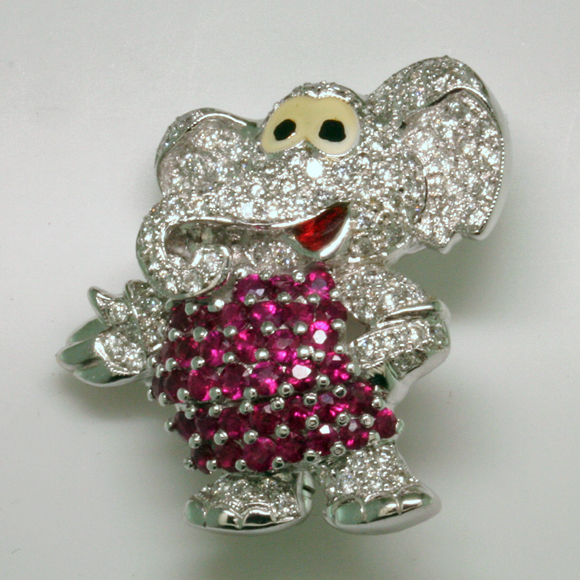
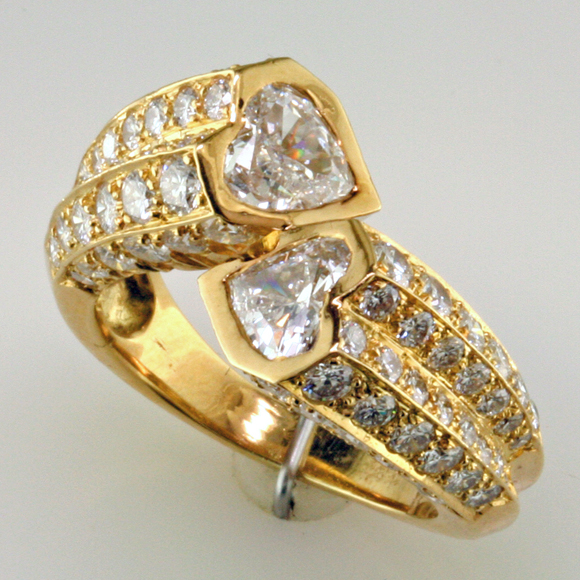
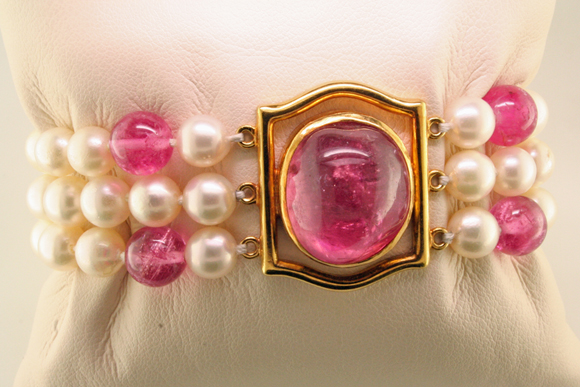
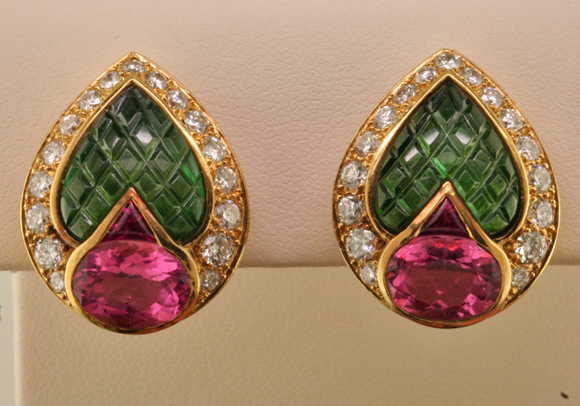
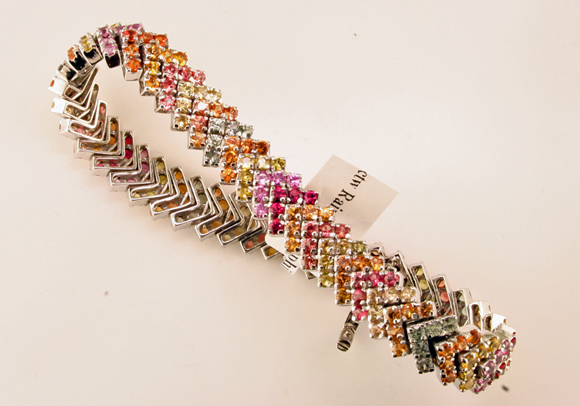
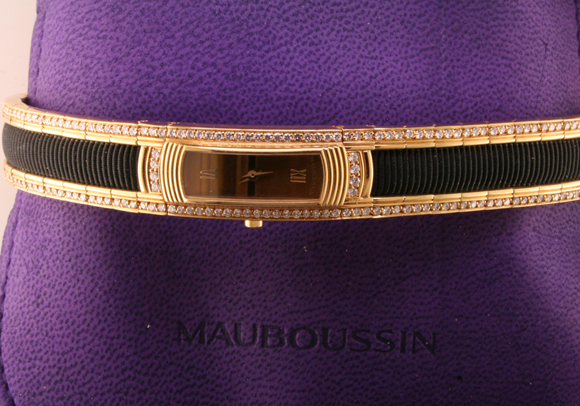

 My observations of the greenish blue stones showed more doubling than I would expect to see in aquamarine, and no doubling at all in the “morganite.” Doubling is a visual effect seen in gemstones that are doubly refractive– when you look thru these gems with magnification, you see doubled images of the inclusions and the facet edges on the opposite side. The effect is sort of like what you see when you look at 3D images without the special glasses.
My observations of the greenish blue stones showed more doubling than I would expect to see in aquamarine, and no doubling at all in the “morganite.” Doubling is a visual effect seen in gemstones that are doubly refractive– when you look thru these gems with magnification, you see doubled images of the inclusions and the facet edges on the opposite side. The effect is sort of like what you see when you look at 3D images without the special glasses.